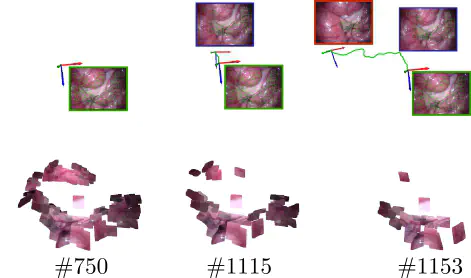 Direct and Sparse Deformable Tracking processing Hamlyn Dataset sequence 6, results after frames #750, #1115 and #1153. Bottom: The map composed of sparse surfels. Top: Camera Trajectory in green.
Direct and Sparse Deformable Tracking processing Hamlyn Dataset sequence 6, results after frames #750, #1115 and #1153. Bottom: The map composed of sparse surfels. Top: Camera Trajectory in green.
Abstract
Deformable Monocular SLAM algorithms recover the localization of a camera in an unknown deformable environment. Current approaches use a template-based deformable tracking to recover the camera pose and the deformation of the map. These template-based methods use an underlying global deformation model. In this paper, we introduce a novel deformable camera tracking method with a local deformation model for each point. Each map point is defined as a single textured surfel that moves independently of the other map points. Thanks to a direct photometric error cost function, we can track the position and orientation of the surfel without an explicit global deformation model. In our experiments, we validate the proposed system and observe that our local deformation model estimates more accurately and robustly the targeted deformations of the map in both laboratory-controlled experiments and in-body scenarios undergoing non-isometric deformations, with changing topology or discontinuities.